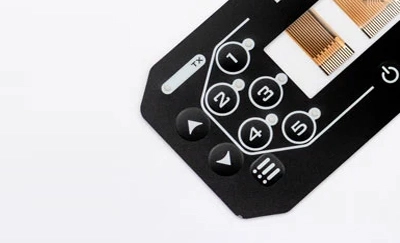
Film switch integrates switch buttons, panel functional text, labels, trademarks, transparent windows, and display windows into one, and adopts a multi-layer integral sealing structure, with characteristics such as friction resistance, waterproof, dustproof, resistance to harmful gases, long service life, and stable performance.
Long service life: The working life of a film switch is tens of times that of an ordinary mechanical switch. The service life of a thin film switch can reach more than 10,000 times, while the service life of a traditional switch is at most 100,000-200,000 times.
Small size, light weight: The total thickness of a film switch is generally between 1.0-1.5mm, equivalent to the thickness of an ordinary aluminum panel.
Good sealing performance: Since the film switch is a fully sealed structure, it has the ability to prevent fire, dust, explosion, and corrosion by harmful gases. It can work in extremely harsh environmental conditions, such as in electrostatic copiers, to prevent charged toner from entering the switch and causing a short circuit. However, traditional film switches are prone to malfunction in humid environments.
Good decoration: The appearance of film switches is matt shade with diffuse reflection, with a soft surface, which is beneficial to visual protection and instrument monitoring. In comparison, traditional switches are relatively monotonous.
Economical: Film switches are produced based on a single design, while traditional switches need to go through repeated modifications of drawings and several complex processes and molding to be completed.
In general, custom membrane switches are a new type of electronic component that uses a flat multi-layer integral sealing structure to seal key switches, panels, labels, symbol displays, and gaskets together. It has the characteristics of long service life, beautiful appearance, and wide application. So what issues should be noted when using such film switches?
The surface should be clean and not bulge. Before and after use, it should be cleaned and treated appropriately for dust and oil.
There is a bubble film between film switches, which is generally used to reduce the pressure on the buttons and prevent button failure. Therefore, it should be kept well and not discarded casually.
The transparent film on the front and back is used to protect the display window and should not be easily torn off.
After taking out parts of the film switch, do not tie it too tightly and tie it back to its original state.
Film surface pasting and film switches with a large touch need to be stored vertically in boxes to prevent long-term pressing of buttons.
Lead wires should be well protected and not placed downward.
If there is a display window, be careful to prevent material bending and leaving creases.
Film switches should be stored indoors at room temperature and take measures to prevent dust and moisture. The surrounding air should not contain acidic, alkaline, or other corrosive gases.
These are the precautions we need to pay attention to when using custom membrane keyboard. When using them, we should also be careful and follow their rules and regulations, and regularly maintain them to ensure their long-term use.